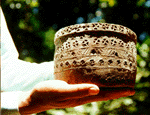HISTORY
LAND BRIDGES - the first migrations
The Philippines--a lush archipelago of 7,107 tropical islands--was formed volcanically 5 million years ago. The islands were originally peopled by early tribes who migrated down over land bridges from the Asiatic mainland. According to historians, the first to make the migration were the short frizzy-haired Negritos (also called Aeta, or Ita) who currently live in small isolated rural settlements along the northeast coast of Luzon, overlooking the South China Sea and Fuga Island. The area is rich with prehistoric artefacts. Fossils of extinct mammals and stone tools as old as five million years have been found in the region.
FUGA ISLAND - "the missing link in the land bridge"
Although the last of the land bridges sank into the ocean 5,000 years ago,
it is surmised that one of them extended westward through the Palawan
Islands to Borneo and Indo-China. A lesser known northern land bridge (the
peaks of which are Fuga and the Babuyan Islands) once connected North Luzon
and the northern islands with Taiwan. Mr. Duck Kim, a Korean-born
environmental scientist (and editor of the new Fuga documentary film) has
topographical evidence of the northern land bridge. Kim's underwater maps
reveal a submerged mountain-like ridge that links Fuga and the Babuyans and
Batanes Islands with Taiwan and mainland China. Corroborating the northern
land bridge, Professor Zenaida Uy, a renowned Filipina anthropologist who
travelled across North America on an international speaking tour professes:
"The Philippines was originally peopled by early tribes from Siberia and China who migrated down over a land bridge that once connected China and Taiwan with the Philippines. And when they made their long journey south, they brought their dead ancestors with them in big clay jars."
NUMEROUS ARCHAEOLOGICAL SITES - on an island trapped in time
Karie Garnier, a Unesco-endorsed photographer and published author, documented prehistoric burial jars at several locations on Fuga--his wife Violeta's ancestral island. But there was a peculiar risk, as Garnier explains: "The Elders forewarned me that 'Fuga is loaded with spirits'. They told me, if you touch the jars you'll get sick. I soon learned why my new family respects and fears the ancient burial jars. Under the guidance ofthe Elders, I appeased the primal spirits (and my new family) with a traditional Ilokano offering of tobacco, food and prayers". Over the next three years, Garnier and a handful of his in-laws explored the remote island and discovered numerous terra cotta burial jars and other mysterious artefacts hidden at locations around the island. One of the sites, a rugged aboriginal cemetery, contained more than 100 burial jars. According to the Elders, many of them were smashed open in 1954 by an American couple (grave robbers) looking for gold. According to the Elders, many gold items and jewelleries were stolen from the burial jars. Some jars were decorated with dragons (see photos in the gallery). Most of the jars were in shards. In all cases, the bones inside had totally disintegrated, suggesting theburials were prehistoric. When Garnier asked the Elders if there were any jars containing bones, the resounding answer was: "Yes! Lots of them. All over the island."
ISLANDS IN THE SUN? - some are cemeteries
The Elders say Fuga is blessed with a network of underground caves. The caves are considered sacred. While exploring one of the caves, Garnier discovered a dusty but magnificent clay jar approximately eight-inches wide. The ornate markings (see photo) prove the jar was incised while still wet. To learn more about the mysterious treasures, Garnier consulted several archaeologists as well as a Chinese scholar familiar with the jars of the dynasties. After studying Garnier's video of the small ornate jar, Dr. Liu deemed it "an early Chinese  ceremonial jar". Garnier also contacted anthropologist Zenaida Uy and told her some of the details about the ancestor jars he found on Fuga. When Garnier told Uy that Fuga was in the northernmost tip of the Philippines, the excited professor said: "Wow! You may have found the missing link in the land bridge. You must have been guided by God!" Archaeologist Rey Santiago of the National Museum in Manila told Garnier, "The early people designated certain islands as cemeteries." Archaeologists from various South East Asian countries confer that the burial jars "point to the origins of life." Reviewing his eight-year study of Fuga and its mysterious jars, Garnier concludes: "The early people of this region chose inspirationally beautiful islands as eternal homes for the dead."
ceremonial jar". Garnier also contacted anthropologist Zenaida Uy and told her some of the details about the ancestor jars he found on Fuga. When Garnier told Uy that Fuga was in the northernmost tip of the Philippines, the excited professor said: "Wow! You may have found the missing link in the land bridge. You must have been guided by God!" Archaeologist Rey Santiago of the National Museum in Manila told Garnier, "The early people designated certain islands as cemeteries." Archaeologists from various South East Asian countries confer that the burial jars "point to the origins of life." Reviewing his eight-year study of Fuga and its mysterious jars, Garnier concludes: "The early people of this region chose inspirationally beautiful islands as eternal homes for the dead."
THE FUGA DOCUMENTARY
For more information on Fuga and its burial jars see The Silent Natives Of Fuga, a new documentary film produced in cooperation with Simon Fraser University and The National Film Board of Canada.
SELF-SUFFICIENCY - traditionally speaking
 The early indigenous groups dispersed throughout the islands, and
flourished independently, sustaining themselves on an abundance of tropical
vegetation, easily-cultivated crops and a cornucopia of seafoods and wild
meat. They had little need to contact or barter with other groups. Onofre
D. Corpuz, renowned historian and author of 'The Philippines' explains:
"The benevolence of nature and tropical geography, without the threat of
severe winters or parched summers, limited the requirements of life . . .
production was for consumption . . . the economies of the dispersed
settlements were each self-sufficient; therefore they did not produce
surpluses. This economic self-sufficiency and absence of surpluses removed
the basis of exchange and limited transport, communication, and technology.
Contacts between barangays or tribes were necessarily limited . . .
Self-sufficient economically, and having the same commodities, the
communities did not enter into an exchange economy. What rare exchange
there was among them took the form of rudimentary barter."
The early indigenous groups dispersed throughout the islands, and
flourished independently, sustaining themselves on an abundance of tropical
vegetation, easily-cultivated crops and a cornucopia of seafoods and wild
meat. They had little need to contact or barter with other groups. Onofre
D. Corpuz, renowned historian and author of 'The Philippines' explains:
"The benevolence of nature and tropical geography, without the threat of
severe winters or parched summers, limited the requirements of life . . .
production was for consumption . . . the economies of the dispersed
settlements were each self-sufficient; therefore they did not produce
surpluses. This economic self-sufficiency and absence of surpluses removed
the basis of exchange and limited transport, communication, and technology.
Contacts between barangays or tribes were necessarily limited . . .
Self-sufficient economically, and having the same commodities, the
communities did not enter into an exchange economy. What rare exchange
there was among them took the form of rudimentary barter."
PEACE RITUALS
|
"The barangays developed rituals and devices for preserving the peace and for averting or minimizing conflict. The mechanisms consisted principally of respect for someone else's person or domain, great caution between strangers, polite forms of language and honorific address . . . The Filipino dialects to this day abound in these politenesses, and Filipinos still speak to strangers in a language that goes to great lengths to avoid hurting anyone's feelings." (from 'The Philippines' by Onofre D. Corpuz, Prentice Hall, NJ)
|
 |
 ceremonial jar". Garnier also contacted anthropologist Zenaida Uy and told her some of the details about the ancestor jars he found on Fuga. When Garnier told Uy that Fuga was in the northernmost tip of the Philippines, the excited professor said: "Wow! You may have found the missing link in the land bridge. You must have been guided by God!" Archaeologist Rey Santiago of the National Museum in Manila told Garnier, "The early people designated certain islands as cemeteries." Archaeologists from various South East Asian countries confer that the burial jars "point to the origins of life." Reviewing his eight-year study of Fuga and its mysterious jars, Garnier concludes: "The early people of this region chose inspirationally beautiful islands as eternal homes for the dead."
ceremonial jar". Garnier also contacted anthropologist Zenaida Uy and told her some of the details about the ancestor jars he found on Fuga. When Garnier told Uy that Fuga was in the northernmost tip of the Philippines, the excited professor said: "Wow! You may have found the missing link in the land bridge. You must have been guided by God!" Archaeologist Rey Santiago of the National Museum in Manila told Garnier, "The early people designated certain islands as cemeteries." Archaeologists from various South East Asian countries confer that the burial jars "point to the origins of life." Reviewing his eight-year study of Fuga and its mysterious jars, Garnier concludes: "The early people of this region chose inspirationally beautiful islands as eternal homes for the dead." The early indigenous groups dispersed throughout the islands, and
flourished independently, sustaining themselves on an abundance of tropical
vegetation, easily-cultivated crops and a cornucopia of seafoods and wild
meat. They had little need to contact or barter with other groups. Onofre
D. Corpuz, renowned historian and author of 'The Philippines' explains:
"The benevolence of nature and tropical geography, without the threat of
severe winters or parched summers, limited the requirements of life . . .
production was for consumption . . . the economies of the dispersed
settlements were each self-sufficient; therefore they did not produce
surpluses. This economic self-sufficiency and absence of surpluses removed
the basis of exchange and limited transport, communication, and technology.
Contacts between barangays or tribes were necessarily limited . . .
Self-sufficient economically, and having the same commodities, the
communities did not enter into an exchange economy. What rare exchange
there was among them took the form of rudimentary barter."
The early indigenous groups dispersed throughout the islands, and
flourished independently, sustaining themselves on an abundance of tropical
vegetation, easily-cultivated crops and a cornucopia of seafoods and wild
meat. They had little need to contact or barter with other groups. Onofre
D. Corpuz, renowned historian and author of 'The Philippines' explains:
"The benevolence of nature and tropical geography, without the threat of
severe winters or parched summers, limited the requirements of life . . .
production was for consumption . . . the economies of the dispersed
settlements were each self-sufficient; therefore they did not produce
surpluses. This economic self-sufficiency and absence of surpluses removed
the basis of exchange and limited transport, communication, and technology.
Contacts between barangays or tribes were necessarily limited . . .
Self-sufficient economically, and having the same commodities, the
communities did not enter into an exchange economy. What rare exchange
there was among them took the form of rudimentary barter." 